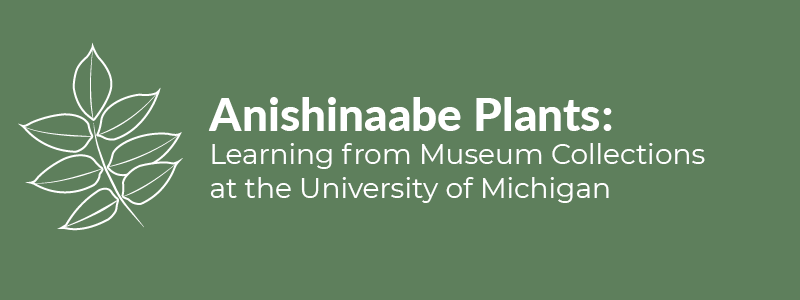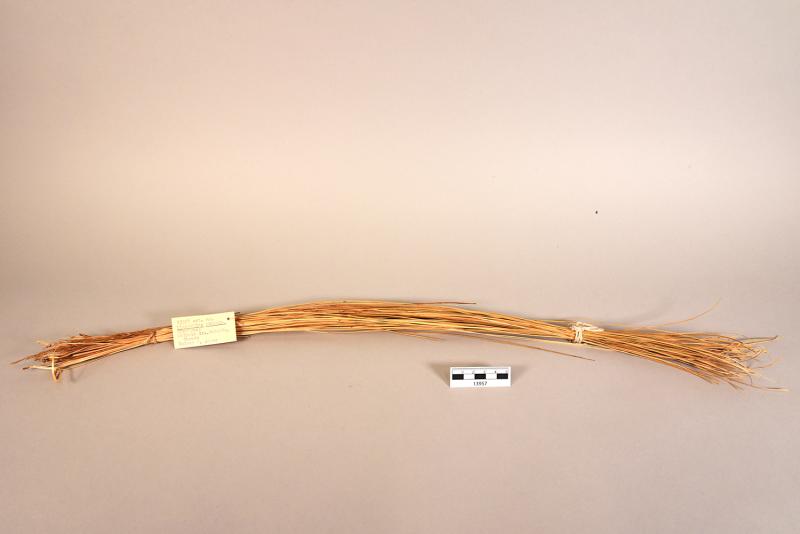Sweetgrass Basket
The Sturgeon family showed Volney Jones how they made this basket of coiled sweetgrass, which Jones called a "trinket basket" in his 1936 article Some Chippewa and Ottawa Uses of Sweet Grass (see resources).
Before Mrs. (Winnie) Sturgeon wove the basket, her husband, Levi Sturgeon, and her brother, Gerald Osahgee, showed Jones how they collected sweetgrass (Hierochloe odorata). They told Jones that the best time to harvest was during the summer (July to September), before it began to dry out. They grasped several shoots near their base and pulled steadily until the stems broke from the root stock. They told Jones that careless jerking would break the shoots above the ground surface and were less desirable. because they needed to be trimmed and were less desirable.
The sweetgrass was harvested from what Jones calls "a very good stand" near the Sturgeon's house where it had been transplanted several years before by Winnie's father, Dave Osahgee. He chose this location because it was damp and there were other plants that provided shade of the young shoots.
Once the sweetgrass was gathered, it was cured. The Sturgeons dried the sweetgrass on a stove until it curled. Then it was tied it in bunches and hung it above the stove. The cured sweetgrass was then tightly wrapped in newspaper, stored in the attic until it was needed.
The materials that Mrs. Sturgeon used to make the basket were: heavy black thread, a white thread, a sewing needle, a piece of beeswax, a brass thimble, and cured sweetgrass. Mrs. Sturgeon showed Jones how to made coils from strands of sweetgrass, arranged the coils into a cylindrical shape, and then tied together using vertical threads. She coated the thread with beeswax to make it easier to pull through the coils of sweetgrass.
Using a similar technique, she made the lid of the basket. A few stitches of white thread creates a hinge between the lid and the basket. This illustration shows the details of the lid and the attachement.
Wiingaashk - sweetgrass
"If we use a plant respectfully it will stay with us and flourish. If we ignore it, it will go away.”
Anishinaabe elder as recounted by Robin Kimmerer in Braiding Sweetgrass
The Anishinaabemowin word for sweetgrass, Wiingasshk, means “fragrant grass” and references its sweet vanilla-like smell. In Anishinaabe origin stories, Wiingaashk was the first plant planted on Turtle Island (earth). Today, member of the Walpole Island First Nation continue to harvest it.
Sweetgrass is now scarce in many locations where it grew historically. In Braiding Sweetgrass (see resources), Robin Kimmerer describes a study that explored the impact of harvesting on sweetgrass. It compared two types of harvesting commonly used by Anishinaabe basket makers: breaking off several stalks from the roots (the technique used by the Sturgeons) and pinching off stalks. With both harvesting techiques, only a portion of the sweetgrass was harvested from the study plots, following Anishinaabek practices.
Over the course of two years, the study compared the plots with different harvesting techniques to a nearby control plot– a stand of sweetgrass that was not harvested. The results showed that the plots where sweetgrass was harvested thrived, regardless of the harvesting technique that was used. However, the sweetgrass did poorly in the control plot. Kimmerer concludes that “sweetgrass flourishes when it’s harvested and declines when it is not,” as long as it is harvested honorably by gathering only a portion of the available plants.



